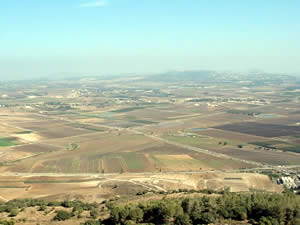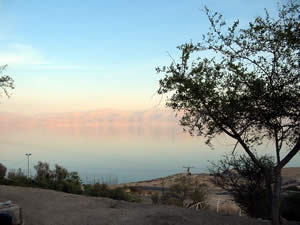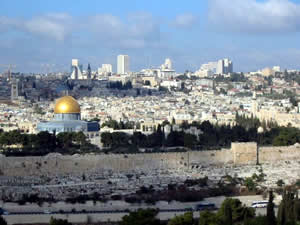Two Weeks in the Promised Land
Several weeks ago, my wife and I toured Israel and Jordan for the first time. It was an experience we’ll never forget and one we’d love to repeat. It’s also an experience we’re eager to recommend to others. Every Bible-believing Christian should seriously consider visiting the Promised Land, and every church should consider sending its pastor(s) there. Here’s why.
 1. The power of geography
1. The power of geography
Seeing Israel firsthand makes its geography unforgettable. And when the geography is more memorable, the history is more memorable. That fact takes the learning well beyond the academic and deep into the spiritual. The history of the land is the story of God’s dealings with His people over thousands of years, and nothing drives the story home like being where it happened.
We stood on Mount Carmel not far from where Elijah called down fire. We looked down at the Kishon, where he disposed of the prophets of Baal. We drove through the Jezreel Valley (Right: The Jezreel Valley from Mount Carmel), where Elijah ran some 20 miles and reached Jezreel ahead of Ahab’s chariot.
For me, the power of the geography has continued even after returning home. I’ve read of many other events connected to these places, including some I never noticed before.
If there is value in being able to call to mind the triumphs and failures of God’s people through the ages, there is value in spending some time where these events happened.
And the Lord said to Abram, after Lot had separated from him: “Lift your eyes now and look from the place where you are—northward, southward, eastward, and westward; for all the land which you see I give to you and your descendants forever… . Arise, walk in the land through its length and its width, for I give it to you” (Gen. 13:14-15, 17, NKJV).
Then Moses went up from the plains of Moab to Mount Nebo, to the top of Pisgah, which is across from Jericho. And the Lord showed him all the land of Gilead as far as Dan, all Naphtali and the land of Ephraim and Manasseh, all the land of Judah as far as the Western Sea, the South, and the plain of the Valley of Jericho, the city of palm trees, as far as Zoar. Then the Lord said to him, “This is the land of which I swore to give Abraham, Isaac, and Jacob, saying, ‘I will give it to your descendants.’ I have caused you to see it with your eyes” (Deut. 34:1-4).
 2. A better context
2. A better context
Being in Israel also provides an enhanced context for interpreting Scripture. Countless learned-and-forgotten details of life in biblical times can find a more vivid and intense place to live in the mind. That fact is true because, despite the passing of millennia, much in Israel is still the same, and much is so unlike everyday life here in the USA. (Left: The Dead Sea from the En Gedi)
Visitors to Israel walk stone streets, climb ruins in dry and thirsty lands, watch the Jordan roll slowly by, taste Galilean fish (as well as olives prepared a dozen different ways), and hear camels bray (“croak”?). The experience has to make detached cultural tidbits click as they haven’t before.
The result is a better intuitive feel for what circumstances were like for the writers of Scripture and the audiences for which they wrote. And anything that brings us closer to the original setting of a Scripture passage brings us closer to correctly understanding its meaning.
3. An expanded sense of time
I’ve often laughed at the shortsightedness of teens who think a song from the 80s is “old.” But here in the USA, everything is new, and that fact impacts all of us. It makes us impatient. Here “historical preservation” means making a museum out of the Farnsworth House—built in 1951!
But in Israel that temporal shortsightedness fades quickly. Visitors find that their sense of oldness is gradually stretched and stretched until they discover they really had no sense of “old” before.
Halfway through our second day of walking around “Old City” Jerusalem, our guide paused to describe an ancient-looking gate. With interest, I waited for him to tell us how old it was. When he said it had been built in the 16th century, I immediately thought, Oh, it’s new. (Right: The Lion Gate in Old Jerusalem)
In some parts of Israel, guests can view structures that predate the conquest of Canaan. As a result, they begin to feel that buildings constructed in the 4th century then partly destroyed and rebuilt in the 12th century (such as the Church of the Holy Sepulchre) are not especially old. When we visited the church of St. Peter Gallicantu (the supposed location of Peter’s denial of Jesus), I mumbled “This looks like it was built last week,” and meant it. In reality, it was built in 1931.
Why is this stretching of the sense of time a good thing? The question is best answered by another question. How can we feel as we should about the Ancient of Days if we really have no feel for the word “ancient”? Visiting Israel greatly enhances one’s ability to understand what “long ago” means. As a result, it enhances one’s ability to grasp what “waiting a long time” means.
Tell and bring forth your case;
Yes, let them take counsel together.
Who has declared this from ancient time?
Who has told it from that time?
Have not I, the Lord?
And there is no other God besides Me,
A just God and a Savior;
There is none besides Me (Isa. 45:21).
4. A spiritual jolt
For many, being where Abraham, Moses, Elijah, Paul, and Jesus lived and worked is spiritually reinvigorating. But I recommend caution here.  To many, “Holy Land” means “a place that is closer to God” and “a place where I can sense God’s presence in a more powerful way.” So they go with great anticipation. Several in our tour group expressed this attitude, and some evidently felt their expectations were met. Others seemed disappointed. (Left: The Eastern Wall from the Mount of Olives)
To many, “Holy Land” means “a place that is closer to God” and “a place where I can sense God’s presence in a more powerful way.” So they go with great anticipation. Several in our tour group expressed this attitude, and some evidently felt their expectations were met. Others seemed disappointed. (Left: The Eastern Wall from the Mount of Olives)
But Scripture doesn’t encourage us to view the land of Israel this way. Jesus promised that He would be with us always (Matt. 28:20) and that wherever two or three would gather, He would be among us (Matt. 18:20). And we who belong to Christ have received the Spirit of Christ (Rom. 8:9) Himself. The holy temple has been replaced with our bodies (1 Cor. 6:19). It’s impossible for us to go anywhere closer to God.
Some who tour Israel are also disappointed by the way some of the “holy sites” look. For many of us, edifices built with the goal of evoking a sense of holiness and awe through gold plating, incense, and darkness just seem ostentatious, gloomy, and eerie. As Westerners with a strong connection to the Protestant branch of the tree, we expect holiness to look much different—and not smell at all.
So it’s important to go with the right expectations. Expect to learn much, to feel a stronger connection to the work of God over the millennia, to read the Bible with far greater sensitivity to places and what it was like for people living in them. Along the way, a spiritual shot in the arm may occur as well.
Money well-spent
Some may argue that the thousands of dollars spent to get to Israel and back would be better used funding missionary work or building better facilities or funding scholarships for seminary students. These are all worthy projects. But funds spent going to Israel or sending your pastor(s) there are investments that result in substantial spiritual dividends. If you can do it, scrape the money together and go. You won’t regret that you did.
 Aaron Blumer, a native of lower Michigan, is a graduate of Bob Jones University (Greenville, SC) and Central Baptist Theological Seminary (Plymouth, MN). He, his wife, and their two children live in a small town in western Wisconsin, where he has pastored Grace Baptist Church (Boyceville, WI) since 2000. Prior to serving as a pastor, Aaron taught school in Stone Mountain, Georgia, and served in customer service and technical support for Unisys Corporation (Eagan, MN). He enjoys science fiction, music, and dabbling in software engineering. |
- 4 views


Discussion